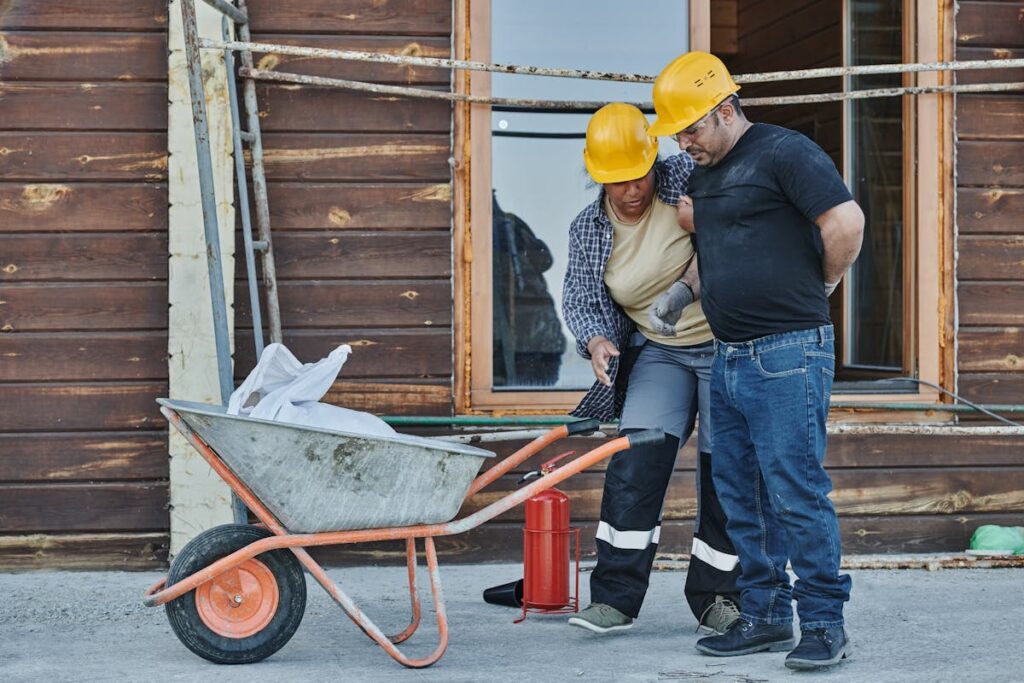After experiencing a fall, individuals must be vigilant about identifying key symptoms that may indicate underlying injuries. Persistent pain and tenderness often signal musculoskeletal damage, while swelling and bruising suggest potential soft tissue trauma. Limited range of motion may denote joint or structural involvement. Neurological symptoms like dizziness, lightheadedness, or confusion require immediate evaluation. Recognizing respiratory or gastrointestinal disturbances, such as difficulty breathing or nausea, is essential for timely intervention and best recovery.
Persistent Pain and Tenderness
Following a fall, individuals often experience persistent pain and tenderness, which can greatly impact daily functioning and quality of life. This pain may evolve into chronic pain if not addressed promptly and effectively. Evidence-based guidelines emphasize the importance of early intervention in pain management to prevent the progression of symptoms. A patient-focused approach involves an extensive assessment of pain characteristics, including intensity, duration, and location. Multimodal pain management strategies are often employed, incorporating pharmacological and non-pharmacological interventions. Analgesics, physical therapy, and cognitive-behavioral therapy are common components of a multidisciplinary treatment plan. Continuous monitoring and reassessment are vital in tailoring pain management strategies to individual patient needs, aiming to restore function and improve the overall quality of life post-fall.
Swelling and Bruising
Swelling and bruising are common physiological responses after a fall, often indicating underlying soft tissue damage or inflammation. Swelling occurs as a result of increased fluid accumulation in the affected area, while bruising manifests due to capillary rupture, leading to localized blood leakage. Effective swelling treatment typically involves the R.I.C.E. method: rest, ice application, compression, and elevation, which aims to reduce inflammation and promote healing. Bruising prevention is challenging post-fall, but mitigating factors such as avoiding re-injury and protecting the area can minimize severity. Healthcare professionals may recommend nonsteroidal anti-inflammatory drugs (NSAIDs) to manage discomfort. Monitoring the progression of these symptoms is essential, as persistent or worsening conditions may necessitate further diagnostic evaluation to rule out more serious injuries.
Limited Range of Motion
In addition to swelling and bruising, a fall can also result in a limited range of motion, which may greatly impair daily activities. This symptom is frequently caused by joint stiffness, where affected areas become rigid, reducing their functional capacity. Such restriction can considerably limit a patient’s ability to perform tasks requiring flexibility and strength. Clinical evidence suggests that timely intervention can mitigate these effects. Implementing targeted mobility exercises is essential for restoring movement and preventing further complications. These exercises aim to gently stretch and strengthen the affected joints and muscles, promoting gradual recovery. Healthcare professionals should tailor exercise regimens to individual needs, ensuring safety and efficacy. Early assessment and intervention can play a pivotal role in optimizing recovery outcomes.
Dizziness and Lightheadedness
Although often underestimated, dizziness and lightheadedness are common symptoms that can manifest after a fall, particularly in older adults. These symptoms may arise from disruptions in the vestibular system of the inner ear, which plays a significant role in maintaining equilibrium. Balance issues following a fall could indicate vestibular dysfunction, potentially leading to an increased risk of subsequent falls and injuries. Clinical evaluation is vital to differentiate between peripheral and central causes of dizziness. A thorough assessment may involve vestibular function tests, such as electronystagmography, to diagnose underlying pathologies accurately. Patient-focused interventions, including vestibular rehabilitation therapy, can improve stability and reduce symptom severity. Early identification and management of these symptoms are essential to enhance patient safety and prevent further complications.
Nausea or Vomiting
Post-fall nausea or vomiting can be attributed to various factors, including vestibular disturbances or head trauma. It is essential for patients experiencing these symptoms to be aware of the potential need for medical evaluation, especially if symptoms persist or are accompanied by neurological changes. Early intervention can prevent complications and guarantee appropriate management.

Causes of Post-Fall Nausea
Following a fall, the onset of nausea or vomiting can be attributed to several underlying physiological mechanisms. One primary cause is vestibular dysfunction, a disruption in the inner ear’s balance system, often precipitated by trauma to the head. Such dysfunction can serve as a potent nausea trigger, as the vestibular system plays a vital role in maintaining equilibrium. Additionally, concussive injuries, even without direct vestibular damage, can alter neural pathways and provoke nausea. The autonomic nervous system may also be implicated, with stress responses and adrenaline surges further exacerbating symptoms. Understanding these mechanisms is important for clinicians in providing targeted interventions and monitoring patients post-fall. This guarantees the management of symptoms and promotes overall patient well-being, aiding in recovery.
When to Seek Help
When should individuals seek medical attention after experiencing nausea or vomiting post-fall? Clinicians advise that seeking medical attention is prudent when these symptoms persist beyond a few hours, intensify, or are accompanied by severe headache, dizziness, or altered consciousness. Nausea or vomiting may indicate a concussion or more severe intracranial injury, necessitating prompt evaluation. Evidence-based guidelines suggest that individuals exhibiting repeated vomiting or any signs of neurological impairment should be considered at high risk and warrant immediate medical assessment. Additionally, individuals with pre-existing conditions, such as anticoagulant therapy, require particular vigilance due to increased bleeding risk. Timely intervention can mitigate potential complications. Therefore, understanding when to seek medical attention is imperative to guarantee ideal patient outcomes following a fall with these symptoms.
Headaches or Migraines
How often do individuals experience headaches or migraines after a fall? Post-fall headaches are a common consequence, with a significant proportion of patients reporting such symptoms. These can be attributed to migraine triggers or concussion effects following head trauma. Migraines may manifest as throbbing pain, often accompanied by nausea and sensitivity to light or sound. Concussion effects can exacerbate these symptoms, potentially prolonging recovery. Clinical evidence suggests that headaches post-fall should be carefully monitored, as they may indicate underlying intracranial pathology. Patient-focused care involves identifying specific migraine triggers, which might include stress, dehydration, or dietary factors, and addressing them promptly. Healthcare providers should evaluate the severity and frequency of headaches or migraines to tailor a thorough treatment plan effectively.
Numbness or Tingling
Numbness or tingling experienced after a fall can result from nerve compression, soft tissue injury, or a more serious underlying condition such as a fracture or spinal injury. It is essential for patients to monitor the persistence and severity of these sensations, as they may indicate complications that necessitate prompt medical evaluation. Immediate consultation with healthcare providers is recommended if numbness or tingling is accompanied by weakness, loss of coordination, or other concerning symptoms.
Causes of Post-Fall Numbness
Following a fall, one may wonder why numbness or tingling sensations occur, and understanding the underlying causes is vital for appropriate management. Post-fall injury can result in nerve damage, which is a primary contributor to these sensations. Nerve damage may occur due to direct trauma from the impact or through the compression of nerves by swelling and hematoma formation. Additionally, abrupt or awkward movements during a fall can lead to stretching or tearing of nerve fibers. This neuropathic disruption impairs sensory signal transmission, manifesting as numbness or tingling. Evidence-based research indicates that peripheral nerves, such as the ulnar or radial nerves, are particularly susceptible. Identifying the precise cause is essential for implementing targeted therapeutic interventions and optimizing patient outcomes.
When to Seek Help
Recognizing when to seek medical attention for numbness or tingling after a fall is essential for preventing further complications. Persistent or worsening symptoms may indicate nerve compression, vascular injury, or spinal cord involvement, necessitating prompt medical evaluation. Such symptoms could impede fall recovery if not adequately addressed. Healthcare providers assess the severity and underlying causes through clinical examination and diagnostic imaging, guaranteeing timely intervention. It is critical to report any associated symptoms such as weakness, paralysis, or loss of bladder control, as these may signify serious injury. Early intervention facilitates ideal recovery outcomes and mitigates long-term damage. Individuals experiencing these symptoms should prioritize seeking professional medical evaluation to guarantee appropriate management and enhance their overall fall recovery process.
Confusion or Memory Issues
Confusion and memory issues are common cognitive symptoms that may arise after a fall, particularly in older adults or individuals with preexisting neurological conditions. These manifestations can indicate underlying brain injury or concussion, warranting immediate clinical evaluation. Memory loss, ranging from mild forgetfulness to more severe cognitive impairment, can signal disruption in brain function. Such disturbances may interfere with daily living activities, impacting the quality of life and necessitating prompt intervention.
Clinical assessments often involve neurological examinations and cognitive testing to quantify and qualify the degree of impairment. Evidence-based strategies, including cognitive rehabilitation and close monitoring, are critical for ideal recovery outcomes. Healthcare providers should prioritize patient-focused care, ensuring thorough management plans tailored to individual needs, minimizing long-term cognitive sequelae post-fall.
Difficulty Breathing or Chest Pain
In addition to cognitive symptoms, physical manifestations such as difficulty breathing or chest pain may also present after a fall, requiring urgent medical attention. Breathing difficulties can indicate potential thoracic trauma, such as rib fractures or pneumothorax, necessitating immediate evaluation. Chest discomfort might be symptomatic of cardiac involvement, especially in elderly individuals or those with pre-existing cardiovascular conditions. Clinical assessment should prioritize auscultation of breath sounds and evaluation of oxygen saturation to identify hypoxia or respiratory compromise. An electrocardiogram (ECG) may be warranted to rule out myocardial injury. Prompt imaging, such as a chest X-ray or CT scan, could be essential in diagnosing internal injuries. Rapid intervention remains critical to prevent complications, ensuring ideal patient outcomes following a fall.
Frequently Asked Questions
Can a Fall Lead to Changes in Appetite or Sleep Patterns?
Appetite changes and sleep disturbances can arise post-fall, linked to pain, stress, or head injuries. Clinical evidence suggests monitoring these symptoms as they may indicate underlying trauma requiring intervention. Patient-focused care is essential for recovery.
How Soon Should I Seek Medical Attention After a Fall?
The individual should undergo an immediate assessment to determine injury severity. If acute symptoms such as severe pain or unconsciousness are present, prompt medical attention is required. Follow-up care is essential to monitor potential complications or delayed symptoms.
Are There Any Long-Term Effects I Should Be Aware of Post-Fall?
Post-fall, individuals should be aware of potential long-term recovery issues, including cognitive effects such as memory impairment, concentration difficulties, and mood changes. Evidence-based research emphasizes patient-focused monitoring to mitigate these risks and optimize rehabilitation outcomes.
What Are the Signs of a Fracture Versus a Sprain After Falling?
Fracture symptoms typically include intense pain, visible deformity, and inability to bear weight. Sprain indicators often involve swelling, bruising, and moderate pain. Both conditions require medical evaluation to determine appropriate treatment and prevent complications.
Can Previous Injuries Affect Recovery From a New Fall?
Previous injury impact can substantially influence the recovery timeline. Existing scar tissue, altered biomechanics, and weakened structures may prolong healing. Evidence suggests that patient-focused rehabilitation strategies can mitigate complications, promoting more efficient recovery despite historical injuries.

